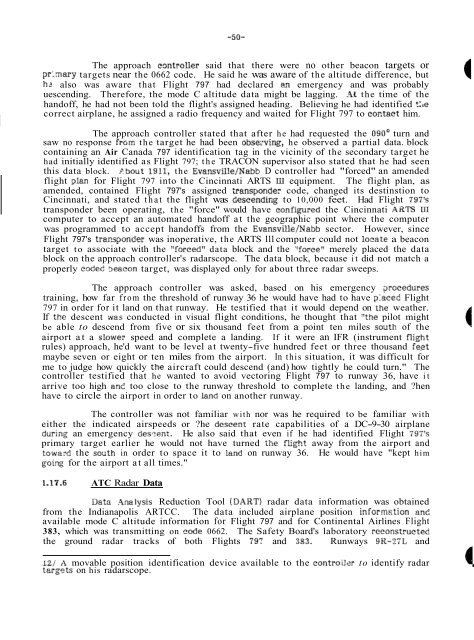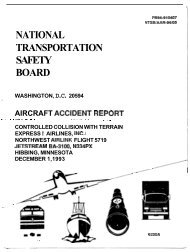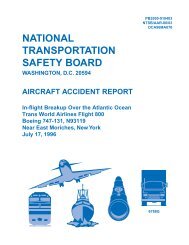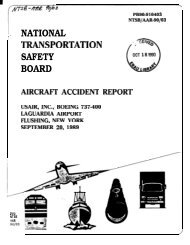NTSB/AAR-84-09 - AirDisaster.Com
NTSB/AAR-84-09 - AirDisaster.Com
NTSB/AAR-84-09 - AirDisaster.Com
Create successful ePaper yourself
Turn your PDF publications into a flip-book with our unique Google optimized e-Paper software.
I<br />
-50-<br />
The approach emtroller said that there were no other beacon targets or<br />
prlcnary targets near the 0662 code. He said he was aware of the altitude difference, but<br />
h? also was aware that Flight 797 had declared nil emergency and was probably<br />
uescending. Therefore, the mode C altitude data might be lagging. At the time of the<br />
handoff, he had not been told the flight's assigned heading. Believing he had identified %e<br />
correct airplane, he assigned a radio frequency and waited for Flight 797 to cor,tact him.<br />
The approach controller stated that after he had requested the <strong>09</strong>0' turn and<br />
saw no response from the target he had been obscving, he observed a partial data. block<br />
containing an Air Canada 797 identification tag in the vicinity of the secondary target he<br />
had initially identified as Flight 797; the TRACON supervisor also stated that he had seen<br />
this data block. Pbout 1911, the Evansville/Nabb D controller had "forced" an amended<br />
flight pla? for Flight 797 into the Cincinnati ARTS III equipment. The flight plan, as<br />
amended, contained Flight 797's assigned transponde: code, changed its destinstion to<br />
Cincinnati, and stated that the flight was Gescendi~g to 10,000 feet. Had Flight 797's<br />
transponder been operating, the "force" would have configdred the Cincinnati AriTS III<br />
computer to accept an automated handoff at the geographic point where the computer<br />
was programmed to accept handoffs from the EvansvUelNabb sector. However, since<br />
Flight 797's tramponder was inoperative, the ARTS 111 computer could not loeaze a beacon<br />
target to associate with the :'forced" data block and the .'force" merely placed the data<br />
block on the approach controller's radarscope. The data block, because it did not match a<br />
properly mded beacon target, was displayed only for about three radar sweeps.<br />
The approach controller was asked, based on his emergency arccedures<br />
training, how far from the threshold of runway 36 he would have had to have p:aeed Flight<br />
797 in order for it land on that runway. He testified that it would depend on the weather.<br />
If the descent :vas conducted in visual flight conditions, he thought that "the pilot might<br />
be able to descend from five or six thousand feet from a point ten miles swath of the<br />
airport at a slowe? speed and complete a landing. If it were an IFR (instrument flzht<br />
rules) approach, he'd want to be level at twenty-five hundred feet or three thousand fe,et<br />
maybe seven or eight or ten miles from the airport. In this situation, it was difficult for<br />
me to judge how quickly the aircraft could descend (and) how tightly he could turn." The<br />
controller testified that he wanted to avoid vectoring Flight 797 to runway 36, have it<br />
arrive too high anl too close to the runway threshold to complete the landing, and ?hen<br />
have to circle the airport in order to lard on another runway.<br />
The controller was not familiar with nor was he required to be familiar with<br />
either the indicated airspeeds or ?he dcscent rate capabilities of a DC-9-30 airplane<br />
diiring an emergency desctn:. He also said that even if he had identified Flight 797's<br />
primary target earlier he would not have turned the Fight away from the airport and<br />
towat-d the soath in order to space it to !and on runway 36. He would have "kept him<br />
goiq for the airport at all times."<br />
1.17.6 ATC Radar Data<br />
Data .4nalysis Reduction Tool (DART) radar data information was obtained<br />
from the Indianapolis ARTCC. The data included airplane position informtion and<br />
available mode C altitude information for Flight 797 and for Continental Airlines Flight<br />
383, which was transmitting on eode 0662. The Safety Board's laboratory reconstructed<br />
the ground radar tracks of both Flights 797 and 383. Runways 9K-2;L and<br />
- 12/ A movable position identification device available to the controilm to identify radar<br />
terz-pts on his radarscope.<br />
.





